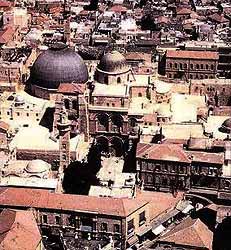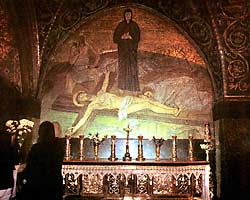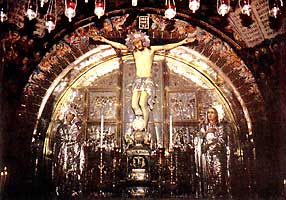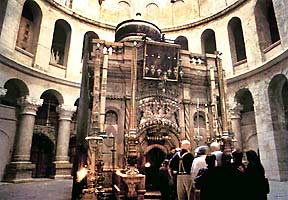| "Then he handed him over to them to be
crucified. So they took Jesus, and he went out, bearing his own
cross, to the place called the place of a skull, which is called in
Hebrew Golgotha." (John 19:16-17)
"When it was evening, there came a rich man from Arimathea,
named Joseph, who also was a disciple of Jesus. He went to Pilate
and asked for the body of Jesus. Then Pilate ordered it to be
given to him. And Joseph took the body, and wrapped it in a clean
linen shroud, and laid it in his own new tomb, which he had hewn in the
rock; and he rolled a great stone to the door of the tomb, and
departed." (Matthew 27:57-60)

A general view of the Church of the
Holy Sepulchre in Jerusalem.
Today the Site of the Holy Sepulchre of
Jesus lies amidst the buildings of the Old City of Jerusalem.
Surrounded by markets, souvenir shops and minarets it invites pilgrims to
meditate about the Mystery of Redemption that unfolded at this spot.
Time and history have left their scars but it has managed to preserve its
incomparable meaning. Even if many a time you find yourself
distracted by the masses of pilgrims walking in all directions, you can
still fall on your knees and proclaim with joy: "Alleluia! Jesus is
Risen, he is not here." Regardless of the Christian
denomination you belong to, you will feel that this spot has witnessed the
"Glory of God in Jesus Christ."
The following excerpts are from the chapter
"The Church of the Holy Sepulchre" in "Beyond the Walls:
Churches of Jerusalem" written by Aviva Bar-Am.
On a recent visit to Jerusalem's Church of
the Holy Sepulchre I stood for a moment in the Chapel of Adam and gazed at
the bare rock beneath Golgotha. A thoroughly bewildered couple
wandered into the tiny chamber, wondering aloud what on earth they had
stumbled into. Where was Calvary? they asked, as they paged
anxiously through a guidebook and tried to locate it on a tiny map.
And where was the Holy Tomb?
No wonder they were baffled. A remarkable edifice built by the
Crusaders over earlier foundations, the Church of the Holy Sepulchre
contains such a curious conglomeration of altars, chapels, and
architectural styles that anyone would be led astray! Every day
hundreds of pilgrims and clergy weave in and out of the church, creating
an atmosphere of noise and confusion not alleviated by the sanctuary's
dark and gloomy interior.
Yet, though finding your way around can be a truly frustrating experience,
this has to be the most dynamic church in the country. Believed by
most of the Christian world to encompass such sacred sites as Calvary
(Golgotha), the Holy Sepulchre, and the cistern in which Helena found the
True Cross, the church is alive with a profusion of languages and a
variety of diverse apparel.
Although today it is the heart of the Old City's Christian quarter and
overflows with visitors, Golgotha was once a bald, rocky hill apparently
situated a few hundred meters outside of the Jerusalem walls. In a
cemetery nearby, wealthy Jew Joseph of Arimathea had prepared a sepulchre
for himself, not knowing that he would one day entomb Jesus within
it. Destined to become the most venerated of Christian sites,
Golgotha and the Sepulchre were lost to the Christians a century after the
Crucifixion: in 135 Roman emperor Hadrian destroyed Jerusalem, rebuilt the
city as Aelia Capitolina, and covered the holy sites with idolatrous
shrines.
Constantine I, the first Roman emperor to embrace Christianity, held an
ecumenical council in 325 to discuss the nature of the Trinity.
Present at that conference was the Jerusalem patriarch, Bishop Macarius,
who urged Constantine's mother Helena to take the Holy Land's neglected
Christian sites under her wing. A year later they toured the Holy
Land together, able to identify Jesus' birthplace in Bethlehem as well as
the Mount of Olives grotto in which Jesus prophesied the destruction of
Jerusalem.
Calvary and the Holy Sepulcre were discovered underneath Hadrian's
temples. Queen Helena razed the pagan shrines, leveled the rocks,
and began construction of a wondrous Christian monument. By 335 a
magnificent basilica - far larger and more grandiose than the contemporary
church - encompassed the Holy Sepulchre, Calvary, and the cistern in which
the pious queen had discovered a piece of the True Cross.
Little remains of the Byzantine basilica, which was destroyed by the
Persian invaders in 614. Repeatedly ravaged and repaired over the
next 400 years, it never returned to its former glory. When the
Crusaders entered Jerusalem on July 15, 1099, they immediately visited the
basilica to find that while the Rotunda had retained some glamour, the
rest of the holy sites that had been contained within the church were only
marked by little chapels. The Crusaders decided to unite all of the
holy sites under one roof and erected the Romanesque church that you see
here today. It took 50 years to build the Church of the Holy
Sepulchre, which was inaugurated in 1149.
Over the centuries various Christian denominations vied for the privilege
of praying next to the holy sites. During periods of restoration
after fires, earthquakes, and war damaged the church, each group altered
the interior according to its own particular tastes while at the same time
latching on to as much property as possible. So much squabbling went
on that in 1852 the Turks issued an edict which declared a situation of
status quo in the holy places. Still in practice today, it means
that the religious arrangements which existed at the time of the decree -
including lighting, decorations and hours of worship - may not be altered.
. .
. . .Begin your tour of the Church of the Holy Sepulchre on the steps
across from the entrance. The church's arched doors, bordered by
marble pillars, are located below corresponding twin windows. Their
splendid lintels were removed to Jerusalem's Rockefeller Museum during the
British Mandate to safeguard them from the elements, but some of the
flower design over the arches is still visible. Note the ladder
under one of the second story windows. It was used over a century
ago for hauling up food to Armenian monks in the church by the
Turks. With the status quo still in force, the ladder seems destined
to remain there forever! . . .
. . .[Now] enter the church (and) immediately turn right to climb 18 steep
steps to Calvary. In Latin, "skull" translates as calva,
it is golgotha in Aramaic and golgoleth in Hebrew.
From these words you get the two terms used today: Calvary and Golgotha,
both meaning "place of the skull" or the site of the
Crucifixion.
Calvary contains two chapels: Latin and Greek Orthodox. The chapel
at the top of the stairs is the Latin oratory, and directly in front of
you is the Latin altar. Before you head toward it, look through a
window to your right to see the 10th station again, but from a different
angle. Then stop to examine the ceiling from a bench near the
altar. Because this chapel was renovated in 1937, most of its
mosaics are new. The one remaining Crusader work, a mosaic of Jesus
in a golden mosaic frame, is larger and lighter than the others.

The 11th Station (Way of the Cross) - The
Latin (Catholic) Chapel.
The chapel's striking altar marks the 11th
Station, the site at which Jesus was nailed to the Cross. A fine
example of Renaissance art, the altar was made in Florence in 1588 and
given to the church by Cardinal Medici a few decades later. Look for
the Medici name. Six panels of hammered silver (four in front and
one on each side) depict scenes from the Passion.

The 12th Station (Way of the Cross) - The
Greek Orthodox Chapel.
To reach the Greek Orthodox chapel on the
other side of the room, pass under an ornamental arch. The Greek
altar is built over the spot which held the Cross. Look to its
right, to see where the rock cracked when "Jesus. . .gave up his
spirit. At that moment the curtain of the temple was torn in two
from top to bottom. The earth shook and the rocks split."
[Matthew 27:50-51]. . .
. . . While waiting in line to enter the
Holy Sepulchre, look around the Rotunda. High above you is a
fabulous gold and white dome and on the walls is a series of balconies
filled with golden lamps. Above the edicule housing the Sepulchre is
a strange black dome. The books call it a "Muscovite
cupola" - probably because of its Russian look.
If you turn around, you will see the Catholicon, a Greek Orthodox
sanctuary facing the Holy Sepulchre. It is also called the Greek
Choir, and during the Crusader period the air here resounded with
hymns. Although this church is usually closed off with a chain you
can still easily see its balconies and ornamental iconastasis. The
Greek Orthodox believe that the center of the world is located in the
Catholicon, and a large urn on the floor marks the spot.

Lines often form in front of the Holy
Sepulchre.
Having reached the beginning of the line
you will now enter the atrium, a small hall typically found in Jewish
burial caves where families and friends of the deceased would
gather. The Sepulchre's atrium is called the Chapel of the Angel.
"After the Sabbath, at dawn on the first day of the week, Mary
Magdalene and the other Mary went to look at the tomb. There was a
violent earthquake, for an angel of the Lord came down from heaven and,
going to the tomb, rolled back the stone and sat on it. The angel
said to the women, "Do not be afraid, for I know that you are looking
for Jesus, who was crucified. He is not here; he has risen, just as
he said. . ." (Matthew 28:1-6).
A podium holds a glass case containing a piece of the rolling stone used
to block up the tomb. Greek Orthodox clergy had to enclose it in
glass because pilgrims kept chopping off chunks to take home with them.
When you enter the tiny chamber, be careful not to bump your head.
The tomb is covered with a marble slab, and decorated with bas reliefs
which portray the Resurrection.
Exit, then walk around the edicule to the backside of the tomb. The
small Coptic chapel located here contains a portion of the Sepulchre's
bare rock. You can touch it if you wish. An opening directly
across from the Coptic chapel leads to a Second Temple period Jewish
cave. If it is not blocked off, follow it to a neglected Syrian
altar and a series of tombs - in one of which Joseph of Arimathea was
traditionally interred.
The last two stops on this tour are associated with Queen Helena. To
reach the first, Helena's Chapel, return to the Stone of Unction.
Pass the mosaic (it should be on your left), the Chapel of Adam, and
another small oratory called the Chapel of the Mocking. At the next
aperture descend 27 steps whose walls are lined with crosses etched into
the stone. Many of them - like those you saw at ST. JAMES CATHEDRAL
(see page 75), were left by Armenian pilgrims who carved one cross for
each member of the family.
Within this Armenian chapel is a main altar dedicated to Helena and a
smaller one consecrated to the penitent thief St. Dismas. The
ancient-looking mosaic on the floor displays Armenian churches. It
was created in 1950 to commemorate the 1915 massacre of Armenian
Turks. Queen Helena found the True Cross in the dank cistern located
beneath this grotto. To visit the underground reservoir, called the
Chapel of the Finding of the Cross, descend 21 more steps from the right
side of Helena's Chapel. According to one tradition, the devout
Helena sat here and supervised excavations in which she found the three
crosses, the crown of thorns, the nails used for pinning Jesus to the
Cross, and the inscription above Jesus' head. A large bronze statue
of Helena and the Cross was donated by an Austrian archduke, Maximilian,
who visited the site in 1855. He was later to become the emperor of
Mexico.
Until 1831, pilgrims were required to pay a fee in order to visit the
Church of the Holy Sepulchre. But during a hiatus in Turkish rule,
when the Egyptians controlled the Holy Land and pro-Christian Ibrahim
Pasha governed Jerusalem, such fees were banned. Since that time
entrance to the church has been free to all comers.
Visiting hours: Daily, from early morning
to sunset.
(Click here to view The Plan of the Holy
Sepulchre today)
|



